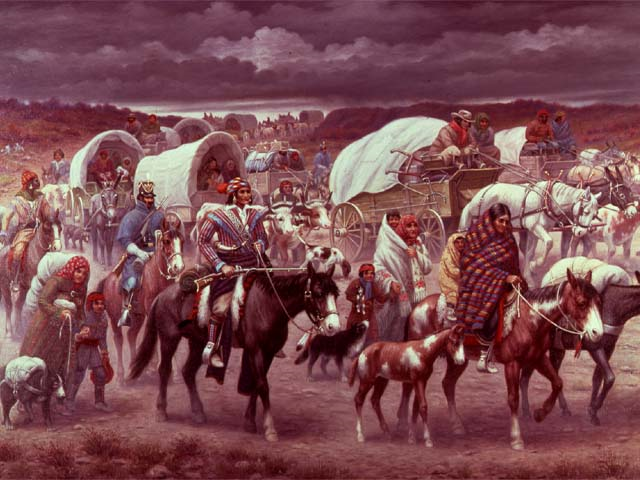The original home of the Cherokee, a branch of the Iroquois, was the southern Appalachian Mountains, including western North and South Carolina, northern Georgia and Alabama, southwest Virginia, and the Cumberland Basin of Tennessee, Kentucky, and northern Alabama. Currently, the Cherokee live in eastern Oklahoma. There are also Cherokee in North Carolina, Missouri, Arkansas, Georgia and Alabama.

The Cherokee Indians arrived in the Smoky Mountains about A.D. 1000. Believed to have been a branch of the Iroquois who moved south from Iroquoian lands in New England. Consisting of 7 clans, the Cherokee Nation stretched from the Ohio River into South Carolina. The Eastern Band of Cherokee Indians lived in the Great Smoky Mountains National Park, believed to be the sacred ancestral home of the Cherokee Nation. Cherokee Indians can trace their history back more than one thousand years. Their society was based on hunting, trading, and agriculture, living in towns until they encountered the first Europeans in 1540, when Spanish explorer Hernando de Sota led an exploration through Cherokee territory. By the time European explorers and traders arrived, Cherokee lands covered a large part of what is now the southeastern United States.
Cherokee Indians lived in small communities, usually located in fertile river bottoms. Homes were wooden, circular frames covered with woven vines and saplings plastered with mud. Each village consisted of up to 50 log and mud huts grouped around the town square, called the Council House, where ceremonial and public meetings were held. The council house was seven-sided to represent the seven clans of the Cherokee: Bird, Paint, Deer, Wolf, Blue, Long Hair, and Wild Potato. Each tribe elected two chiefs -- a Peace Chief who counseled during peaceful times and a War Chief who made decisions during times of war. However, the Chiefs did not rule absolutely. Decision making was a more democratic process, with tribal members having the opportunity to voice concerns.
Cherokee Indians society was a matriarchy. The children took the clan of the mother, and kinship was traced through the mother's family. Women had an equal voice in the affairs of the tribe. Marriage was only allowed between members of different clans. Property was passed on according to clan alliance.
GROWTH AND DEVELOPMENT:
Europeans first settled Cades Cove in 1818. Before their arrival, Cades Cove as part of Cherokee Nation, who called the Cove, Tsiyaha or "place of the river otter." Cherokee Indians never lived in the Cove, but used the land as its summer hunting ground for river otters, elk and bison.
In the early 1800's, Cherokee Indians began a period of change. The Cherokee Nation was established with a democratic government composed of a Chief, Vice-Chief, and 32 Council Members who were elected by the members of the tribe. A constitution and code of law were implemented for the nation. In 1808, Sequoyah, a Cherokee silversmith, invented a system for writing the Cherokee Indians language and within two years, almost all of the Cherokee's could read and write. The Cherokee Council passed a resolution to establish a newspaper for their nation. A printing press was ordered, the type cast for the Cherokee syllabary, and the Cherokee Phoenix was in business.
REMOVAL:
Unfortunately, the Cherokee Indians did not enjoy prosperous times for long. With the discovery of gold on Cherokee lands in 1828 and Andrew Jackson's 1830 Removal Act, calling for the relocation of all native peoples east of the Mississippi River to Oklahoma, the U. S. government forced the Cherokees from their homes in 1838. Almost 14,000 Cherokees began the trek westward in October of 1838. More than 4,000 died from cold, hunger, and disease during the six-month journey that came to be known as the "Trail of Tears." Altogether, about 100,000 natives, including Cherokee, Chickasaw, Seminole and Choctaw survived the journey.
A few Cherokees refused to move and hid among the wilderness of the Great Smoky Mountains, avoiding the army and authorities. These Cherokees, now called the Eastern Band, were allowed to claim some of their lands in western North Carolina in the 1870's. In 1889, this 56,000 acre sect of land was chartered and is now called the Qualla Indian Reservation, home to almost 11,000 descendents.
EASTERN AND WESTERN BANDS:
Prior to the "Trail of Tears," a small group of Cherokees in western North Carolina had already received permission to be excluded from the move west. Those individuals, often called the Oconaluftee Indians, did not live on Cherokee Nation land and considered themselves separate from the Cherokee Nation. Permission for the Oconaluftee Cherokee Indians to remain in North Carolina had been obtained in part through the efforts of William H. Thomas, a successful business man, who had grown up among the Cherokee Indians. For more than 30 years he served as their attorney and adviser.
To
avoid jeopardizing their special status, the Oconaluftee Cherokees
reluctantly assisted in the search for Cherokee Nation Indians who
had fled to the mountains to avoid capture. Among those in hiding was
Tsali who had become a hero to many Cherokees for his resistance to
forced removal. Tsali was being sought because of his role in the
deaths of several soldiers. To prevent further hardships for the
Cherokees still in hiding, Tsali eventually agreed to surrender and
face execution. Due in part to Tsali's sacrifice, many of those in
hiding were eventually allowed to settle among the Cherokee Indians
of western North Carolina. This was to be the beginning of the
Eastern Band of Cherokees.




Ei kommentteja:
Lähetä kommentti